Genre: Fighting Developer: SNK Publisher: Takara Players: 1-2 Released: 1994
In 1994 most gamers both in the arcade and in the comfort of their homes were busy mashing the legendary button combinations of the immortal Street Fighter II. Lurking in the shadows of Capcom’s biggest title was SNK’s own brawler Fatal Fury, which was for the most part incredibly like SF2 by borrowing the same versus style gameplay element and even some of the same character cliches, which would be passed on from fighting game to fighting game for generations.
The story? Well, much like other fighters, from this era, it’s rather sparse. Wolfgang Krauser, a fighter who thinks he’s the toughest thing since Contra or something, has decided to host the next King of Fighters tournament and so the Fatal Fury gang shuffles in for a few more rounds of hand-to-hand combat. With twelve characters present, the roster was very well rounded for an early/mid-nineties fighting game. There was the usual smack-talk banter between fights and ending sequences, but it was all mostly unintelligible and filled with now infamous SNK-style Engrish that was good for comedic value at the very least.
Like its predecessor, Fatal Fury 2 tried to stand out from Street Fighter by offering an interesting gimmick. The game could take place on two different planes: the foreground and the background. Characters could move freely between the planes and even knock their opponent into the other one, which sometimes had strategic value (such as damaging obstacles in the background). The control was tight, perhaps a tad more responsive than Street Fighter II: Special Champion Edition and was an improvement over the original Fatal Fury, especially regarding the plane switching. Pulling off special moves was standard fighting game fare and the usual memorized button combos would put your foes in serious trouble. Playing through the game’s single-player mode was a tough romp, especially on the higher difficulties, where you’d find yourself cursing your head off at the vicious AI. Like all versus fighters, however, the meat and potatoes of this game was the two-player mode where you could beat up your friends in a virtual slugfest.
Graphically, the game was one of the best fighters to look at on the Genesis. Like Street Fighter II, it shipped you off to several exotic locales to fight martial arts warriors around the globe. The backgrounds were breath-taking and almost as fun to watch as the action itself, which is important in a fighting game because unlike fast paced titles (like shmups), you’ll be seeing a lot of the background. One of the coolest features in the game with the background was the passage of time. The first round was held during the day, the second round happened at dusk, and the third round (should one be necessary) took place at night. It was just a little touch, but it made a big visual difference and set a definite mood.
The characters themselves had large sprites that were nicely detailed, though some character designs left a bit to be desired. Big Bear, for example, was an obvious Zangief rip-off. Characters like the game’s hero, Terry Bogard were a refreshing change from Street Fighter, and it was always nice to see a hero character who wasn’t some generic karate dude (no offense to Ryu or Liu Kang). SNK’s talent for interesting character designs that simply radiated cool was already apparent in this early game.
This brings me to the special moves, which were flashy and devastating when in the proper hands. Every character had their own trade-marked moves taken from whatever martial arts school that sired them, as well as an additional super move which could be executed as an act of desperation when your character’s health bar began flashing red. The super moves took a bit more effort to pull off than the standard special attacks, but they were impressive enough to make even the most stalwart Street Fighter II fan blush. Perhaps my only real complaint about the graphics is that a few animations from the arcade version were lost in this port, which is understandable, but it makes the game look and feel choppier than its coin-op counterpart.
The sound is what you’d expect from most fighters. The background themes were tailored to the specific levels and supplemented the overall feel of what they were attempting to convey with their visual style, though nothing was memorable overall. Voice samples, including grunts and groans, were a bit garbled, but this was a problem with the Genesis hardware as a whole. The whacks and thwacks made when hitting your opponent were all present and accounted for and were just as satisfying as any other fighting game.
Unfortunately, Fatal Fury 2 was mostly overlooked — thanks to Street Fighter II and Mortal Kombat — which is a crying shame, as this was one of the best fighters on the Genesis. The fact that it wasn’t much of a financial success has made the game semi-rare though not very expensive find and it’s worth a surf on eBay to locate a copy if you’re a collector looking to round out your Genesis fighting game stock or a fighting game aficionado.
SCORE: 8 out of 10

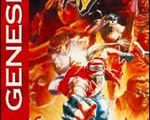
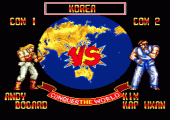
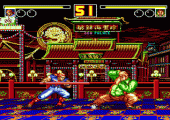
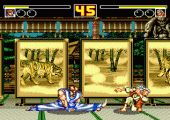
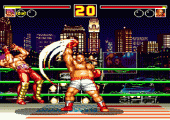
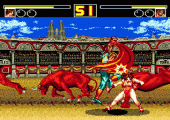
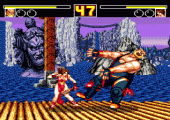
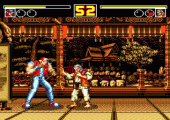
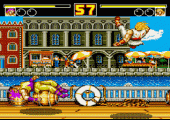
One of the very best and most overlooked fighting games on the Mega Drive. The PAL version is so rare that it makes Mega Man: Wily Wars and Alien Soldier seem as common as Mega Games 1.
The typical gameplay of Fatal Fury is classic, and this port does a good job of transporting it to the Genesis. Controls are second only to Street Fighter II.
The visuals are a mixed back though; having the black border behind the energy bars seems very ancient and unneccessary on the MD, and the game only runs in 256 x 224 unlike the high-res goodness of Samurai Shodown. But the level of detail is very high, destroyable objects and changing time of day add to the atmosphere…and the sprite off ig Bear is huge.
Definately a must-have in the mixed library of Geny-fighters.